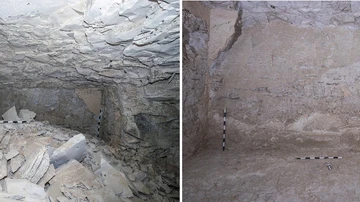If we talk about ancient Egypt, the Name of Tutankhamun. It is the most famous mummy. His grave was discovered in 1922 and after about 3,000 years closed, the bacteria and microorganisms that were released inside were released, causing several deaths among the members of the finding team. The Pharaoh curse They called him. And since then, there has been no other discovery of any other pharaonic tomb. Until now.
An Egyptian-British archaeological mission has discovered The tomb of King Tutmosis II, the last lost grave of the XVIII dynasty (1575 and 1295 BC) of Egypt, as announced on Tuesday the Egyptian Ministry of Antiquities. “The archaeological mission of the Supreme Council of Antiques and the new state investigation foundation managed to discover the tomb of King Tutmosis II, the last lost tomb of the kings of the XVIII dynasty in Egypt,” said the ministry in a statement.
{“@context”: “https://schema.org”, “@type”: “Imageobject”, “URL”: “”, “Uploaddate”: “2025-02-20t07: 58: 15.593+01: 00 “,” Width “:” 1000 “,” Height “:” 567 “}

Discovery of the tomb of the pharaoh Tutmosis II in Egypt | EFE/Ministry of Antiquities of Egypt
The finding of this grave occurred during the Tomb Excavations Number C4whose main entrance and passage were found in 2022, in the area of Valle del Monte Tebas, west of Luxorwhich is located about 2.4 kilometers west in the area of the Valley of the Kings, in the south of the country. In addition, he pointed out that during this season, archaeologists discovered new archaeological evidence that identified King Tutmosis II as owner of the graveand that who carried out his burial procedures was the famous Queen Hatshepsut, as his wife and half sister.
In the grave, parts of Alabaster vessels decorated with inscriptions of the name of King Tutmosis II Like the “deceased king”, along with the name of his main real wife, Hatshepsut, confirming the identity of the owner of the tomb. For his part, the head of the archaeological mission of the English side, Piers Liserland, explained that the tomb is characterized by a Simple architectural designnucleus of the tombs of the successive governments of Egypt after Tutmosis II during the XVIII dynasty.
He also said that the grave includes a corridor with a floor covered with a white plaster layer, which leads to the funeral chamber in the main corridor of the tombwhere the ground level is approximately 1.4 meters higher than the floor of the chamber itself. It is believed that it was used to transport the content of the main grave, including the body of Tutmosis II.
ark “,” Width “:” 1000 “,” Height “:” 567 “}

Funeral chamber of the Egyptian pharaoh Tutmosis II, discovered in Egypt | EFE/Ministry of Antiquities of Egypt
But who was Tutmosis II and what did he do in his reign?
Tutmosis II was the fourth pharaoh of the XVIII dynasty of Egypt – posterior to Amosis I, Amenophis I and Tutmosis I—, who believes that it reigned for a brief period of time. His birth name was Thutmose Aajerenra and it was son of Tutmosis I and one of his secondary wives: Even being the son of a pharaoh, not being the first or progeny of his main wife, he had no right to ascend to the throne. Until He married his half -sister, Hatshepsutfull daughter, thus being able to ascend to the throne.
According to an registration of Asuán, dated in year 1, Tutmosis II suffocated a rebellion against Egyptian sovereignty in Nubia And he could also defeat a group of beduinos nomads in southern Palestine. But beyond this and some constructions – a party courtyard in Karnak, later demolished by Amethotep III, or a funeral temple that his son extended later – Not much more is known about Tutmosis II reign. It is believed that it was very short, between three and 13 years.
With his half -sister and real wife, Hatshepsut, had a daughter, Neferure, and with a secondary wife, a male son, Tutmosis III. When Tutmosis II died, the heir prince to the throne, Tutmosis III, was a minor. Thus, his aunt-mother, Hatshepsut, was crowned Queen Pharaoh and although de facto was She who ruled Egypt For two decades, a district was established with which it was the legitimate pharaoh.
The remains of Tutmosis were discovered in the nineteenth century in a real hiding place, but The pharaonic tomb remained a mystery For more than a century.
Source: Lasexta
Bruce is a talented author and journalist with a passion for entertainment . He currently works as a writer at the 247 News Agency, where he has established himself as a respected voice in the industry.











